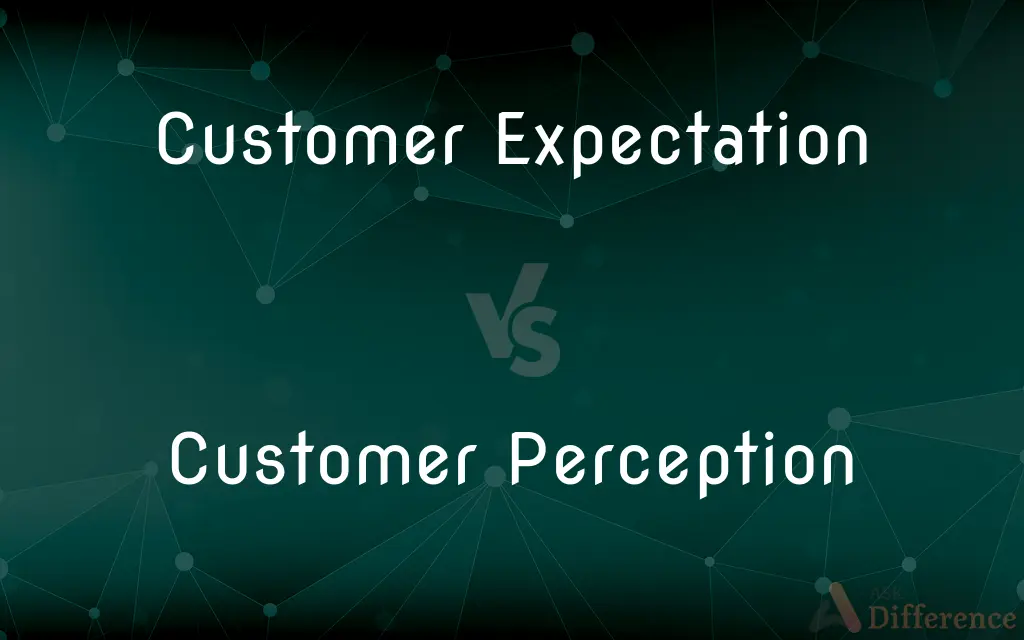Customer Expectation vs. Customer Perception — What's the Difference?
By Tayyaba Rehman — Published on November 1, 2023
Customer Expectation refers to anticipations customers have regarding a product or service, while Customer Perception pertains to how customers perceive or experience same product or service in reality. Both influence customer satisfaction and loyalty.

Difference Between Customer Expectation and Customer Perception
Table of Contents
ADVERTISEMENT
Key Differences
Customer Expectation delineates the pre-purchase assumptions or beliefs held by customers about products, services, or brand experiences. It establishes a benchmark against which the actual performance is measured. Conversely, Customer Perception encapsulates how customers interpret or comprehend a product or service post-purchase, offering a reflective insight into whether the initial expectations were met or not, essentially determining subsequent interactions with the brand or product.
While Customer Expectation can be shaped by past experiences, reviews, and brand promises, it essentially provides a mental picture of what the customer anticipates from a product or service. On the other hand, Customer Perception is molded by the actual interaction and experience with the product or service, thereby acting as a critical evaluative component that weighs the actual performance against the initial expectations, sculpting future buying behaviors.
The alignment or discrepancy between Customer Expectation and Customer Perception can significantly influence a customer’s satisfaction and loyalty toward a brand. High expectations met with favorable perceptions can augment customer satisfaction and loyalty, while any misalignment can lead to dissonance, resulting in potential negative repercussions for the brand in the form of unfavorable reviews or diminished loyalty.
While businesses seek to accurately gauge and meet Customer Expectation through various methodologies like surveys or feedback mechanisms, understanding Customer Perception necessitates delving into post-purchase experiences and assessing whether the reality aligned with the anticipated promises, which can be executed through reviews, complaints, and feedback, ensuring that the products or services resonate authentically with consumer wants and needs.
Moreover, both Customer Expectation and Customer Perception serve as vital diagnostics in tailoring marketing strategies, service improvements, and product enhancements. By comprehending what customers expect and perceive, businesses can tailor their offerings to not just meet but exceed expectations, ensuring a holistic and satisfying customer journey from pre-purchase anticipation to post-purchase evaluation.
ADVERTISEMENT
Comparison Chart
Stage of Interaction
Pre-purchase
Post-purchase
Influence On
Predicts satisfaction and guides purchase
Dictates satisfaction and influences repurchase
Impacted By
Advertising, word-of-mouth, previous experiences
Actual interaction and product performance
Role in Customer Journey
Guides and motivates purchasing behavior
Shapes subsequent behaviors and loyalty
Evaluation
Forecasts the perceived quality of product/service
Assesses the actual quality experienced
Compare with Definitions
Customer Expectation
Anticipations customers hold about a product/service.
The customer expectation for the new phone was high due to the advanced features advertised.
Customer Perception
The actual experience compared against expectations.
The customer perception was that the item provided value for money.
Customer Expectation
Predictions about a product's performance and quality.
The customer expectation was set by the brand's premium pricing strategy.
Customer Perception
Assessments formed post-purchase or post-interaction.
Positive customer service encounters significantly enhanced customer perception.
Customer Expectation
Forecasts of satisfaction from a product/service.
The customer expectation was that the meal would be worth the price paid.
Customer Perception
Evaluations based on actual usage or experience.
Despite high initial costs, the excellent performance improved customer perception.
Customer Expectation
Beliefs regarding the impending experience with a product/service.
The marketing campaign significantly raised the customer expectation.
Customer Perception
The reality of how a product/service performs.
The customer perception was that the product did not deliver as promised.
Customer Expectation
Prospective evaluation of a product/service.
Due to positive reviews, the customer expectation for the software was quite high.
Customer Perception
Customers’ beliefs shaped by actual interactions with a product/service.
The customer perception of the device was negatively impacted by its short battery life.
Common Curiosities
What influences Customer Expectation?
Advertising, past experiences, and word-of-mouth typically influence Customer Expectation.
How is Customer Perception formed?
Customer Perception is formed through actual interactions and experiences with a product or service.
How can businesses manage Customer Expectation?
Businesses can manage Customer Expectation through accurate advertising, clear communication, and setting realistic promises.
Can Customer Expectation impact purchasing decisions?
Yes, Customer Expectation can significantly guide and motivate purchasing decisions.
Can Customer Expectation be measured?
Yes, through surveys, feedback, and reviews, Customer Expectation can be quantitatively and qualitatively measured.
Does Customer Perception influence brand loyalty?
Absolutely, positive Customer Perception can foster and enhance brand loyalty.
How can companies enhance Customer Perception?
Companies can enhance Customer Perception through quality assurance, excellent customer service, and reliable product performance.
Is Customer Perception critical to product improvement?
Yes, understanding Customer Perception is crucial for businesses to enhance product offerings.
How are Customer Expectation and Customer Perception related?
Customer Expectation sets the pre-purchase beliefs, while Customer Perception evaluates if those were met post-purchase.
How does a negative Customer Perception affect a brand?
Negative Customer Perception can lead to diminished loyalty, unfavorable reviews, and decreased patronage.
Can altering Customer Expectation influence Perception?
Yes, managing and meeting altered Customer Expectation effectively can positively influence Perception.
Why is balancing Customer Expectation and Customer Perception crucial?
Balancing both ensures customer satisfaction, loyalty, and positive word-of-mouth, vital for a brand's success and longevity.
What role does Customer Perception play in repeat purchases?
Positive Customer Perception often leads to repeat purchases and brand loyalty.
Is Customer Expectation static or dynamic?
Customer Expectation is dynamic and can change with market trends, experiences, and peer reviews.
Are there tools to gauge Customer Perception?
Yes, feedback surveys, reviews, and customer interviews are tools to gauge Customer Perception.
Share Your Discovery

Previous Comparison
Short-Term vs. Long-Term
Next Comparison
Direct Costs vs. Indirect CostsAuthor Spotlight
Written by
Tayyaba RehmanTayyaba Rehman is a distinguished writer, currently serving as a primary contributor to askdifference.com. As a researcher in semantics and etymology, Tayyaba's passion for the complexity of languages and their distinctions has found a perfect home on the platform. Tayyaba delves into the intricacies of language, distinguishing between commonly confused words and phrases, thereby providing clarity for readers worldwide.
















































